Abstract
Research on water, energy, and food (WEF) is gradually becoming a global research hotspot in response to threats caused by the overexploitation of resources. In this study, 13,202 documents were selected from the WoS database and CiteSpace to judge frontier development in WEF research. In this study, visualisation research was carried out in 1547 papers that are most relevant to WEF research. The results show that WEF research has gradually increased during the research period, especially since 2015. The Food and Agriculture Organisation of the United Nations, Hoff, and Bazilian have the greatest influence on the promotion of WEF research and there is significant cooperation between institutions and countries. The United States, China, and the United Kingdom were the main contributors. The WEF nexus has become the most important hotspot in WEF research. In this case, 823 papers focused on the WEF nexus were selected to demonstrate the research contents, frontiers and clusters, and methods of the WEF nexus. Applied researches on the WEF nexus, such as security issues and multi-objective optimisation are current frontiers. Some new topics such as the pandemic and geopolitics have not attracted enough attention relative to their potential importance. A comprehensive data platform for the inter-department of water, energy, and food subsystems should be constructed in the near future.
1. Introduction
Water, energy, and food (WEF) are three significant resources closely related to our lives. Water demand is expected to increase by 55% globally between 2000 and 2050 with the increasing usage of industrial, household, and agricultural water (UNESCO. The United Nations World Water Development Report, 2021). According to the statistical data of the BP report, global energy consumption increased by 41.1% from 2000 to 2020 (BP. Statistical Review of World Energy, 2021). The world population surpassed 7.75 billion in 2020 (UNFPA. State of World Population, 2020); however, the per capita arable land area is declining (World Bank Indicators. https://data.worldbank.org/indicator accessed on 16 March 2022). The number of people affected by the food crisis increased by 22 million between 2018 and 2019 (Food Security Information Network (FSIN). Global Report on Food Crises, 2021). Consequently, the world’s resources suffer from the dilemma of increased demand and limited supply. Most European countries such as Malta, Greece, Spain, Portugal, and others face water challenges due to climatic factors such as reduction in groundwater and increasing salinity of water [1]. Developing countries, such as India, have encountered challenges such as groundwater depletion, energy shortages, irrigation system chaos, and food insecurity [2].
Currently, WEF has attracted increasing attention in the research field. This study conducted a visual analysis of the literature on WEF from 2006 to 2021 using CiteSpace, explored the research hotspots in the field, and demonstrated the moving trend of WEF to understand the status and future research trends of WEF. The contributions of this paper are two-fold. Firstly, this paper presents a visual presentation of the history and hotspots of the WEF research, including descriptive statistics, active research scholars, institutions, research scopes, etc. Secondly, with the analysis of the citation burst and knowledge clusters of the WEF nexus, research trends and limitations are all obtained, which can provide a reference for further research.
2. Visualisation Analysis of WEF with CiteSpace
2.1. Descriptive Analysis of WEF Publications
A total of 13,202 studies were collected with the theme of ‘water-energy-food’ from the Web of Science (WoS) from 2006 to 2021, among which 1547 were closely related to the WEF management field (It should be noted that papers related to chemistry, medicine, genetics, etc. are excluded from this research. Only management-related WEF researches are discussed here.). Subsequently, CiteSpace was used for the bibliometric analysis. CiteSpace is a visual software that presents the structure, law, and distribution of scientific knowledge (Official website of CiteSpace: https://sourceforge.net/projects/citespace/ accessed on 10 January 2022). It is chosen as the main tool to conduct a comprehensive analysis of the selected publications. In terms of data processing, the time slice is 1 year, and the source selects all items, including title (title), abstract (abstract), keywords plus (ID), and author keywords (DE). Select Author (Section 2.2), Institution (Section 2.3), Country (Section 2.4), and Keyword (Section 2.5) for the nodes, select Top = 50 for the threshold, and set the others as default values.
The amount of WEF publications published between 2006 and 2021 along with their percentage growths is plotted in Figure 1. The figure shows that research on WEF has continued to rise since 2006, and the increasing trend has accelerated significantly since 2015.
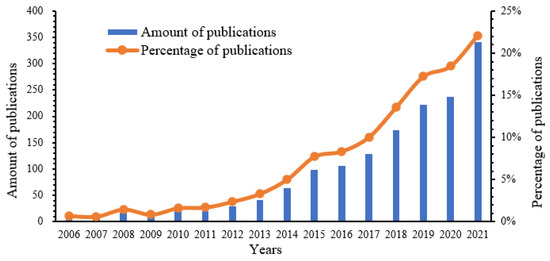
Figure 1.
WEF publications from 2006 to 2021.
2.2. Analysis of Co-Cited Authors in WEF
The analysis of co-cited authors can not only obtain the distribution of highly cited authors but also find scholars with similar research fields. Co-cited frequency indicates the number of times that two or more documents are cited together. Figure 2 shows the top ten co-cited scholars in the WEF field.
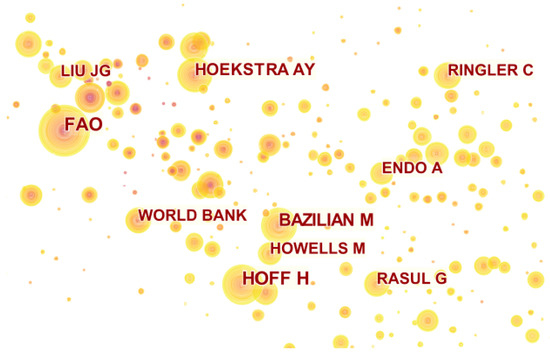
Figure 2.
Co-cited author.
The size of nodes represents the co-cited frequency: the bigger the nodes, the higher the co-cited frequency. The distance between nodes (researchers) represents the similarity between the research topics of researchers. The closer the distance between the nodes, the closer the academic relationship between the authors.
The co-cited author network was composed of small independent sub-networks and the top three co-cited author networks were headed by FAO (385 times), Hoff H (356 times), and Bazilian M (298 times) (Figure 2). The sub-network centralised around the FAO is an intensive research group containing at least ten nodes. The FAO is an official international organisation for world food and agriculture. Liu of Michigan State University is one of the closest co-cited authors with the FAO. His research emphasises environmental protection in the relationship between humans and nature [3]. Another sub-network was headed by Hoff from the Potsdam Climate Research Institute. He is committed to solving the growing water gap in food production. They propose that energy, agriculture, trade, and climate must be considered when managing water [4,5]. In the sub-network, Bazilian considered the future energy supply as his research point. He also examined the integration of WEF with systemic thinking [6,7].
Twenty-five authors are co-cited more than 100 times in smaller co-citation networks. Some of these scholars have focused on calculating the number of land uses and exploring the water and carbon footprints of bioenergy [8,9]. Discussions have also taken place on improving WEF utilisation efficiency to strengthen coordination and reduce dependence intensity on WEF [10,11].
2.3. Major Research Institutions in WEF
Figure 3 shows a network of collaborations between research institutions. Similar to the co-citation author network, the size of the node represents the number of each institutional publication. The connection between nodes indicates the existence of a cooperative relationship; the thicker the links, the more intense the cooperation between them. Figure 3 shows that the top five institutes are the Chinese Academy of Sciences (CAS, 54 papers), Beijing Normal University (47 papers), University of Texas (38 papers), International Institute of Applied Systems Analysis (27 papers), and Oxford University (25 papers). The papers published by these institutions account for 12.3% of the total articles issued. Taking CAS as an example, there are 54 extended lines in Figure 3, representing more than 50 co-operators of CAS. The United Nations Economic and Social Commission for Asia and the Pacific (ESCAP) has the closest cooperation relationship with the CAS, followed by Clark University, the Ministry of Land and Resources of China, and the China Agricultural University.
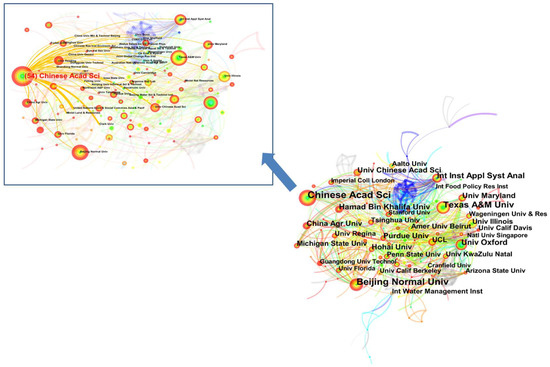
Figure 3.
Organisation cooperation network.
2.4. Topic Distribution in WEF Research
With the development of globalisation, cooperation among different countries is inevitable. The national cooperative network of WEF research is shown in Figure 4. Each node represents a country, and the size represents the number of publications from that country. The thickness of the line represents the degree of cooperation. Publications in the United States have maintained a leading position with China close behind. The top five centres in the national cooperation network were the United States (554 papers), China (300 papers), England (187 papers), Germany (139 papers), and the Netherlands (98 papers). If we consider the United States and China as examples, we can see that the United States is still the most active country engaged in cooperative research with others, while Germany and Kazakhstan have the closest cooperative relationship with China. From the perspective of the nationwide distribution of cooperation networks, Europe (901 papers), North America (653 papers), and Asia (567 papers) were the top three regions in international cooperation in WEF research.
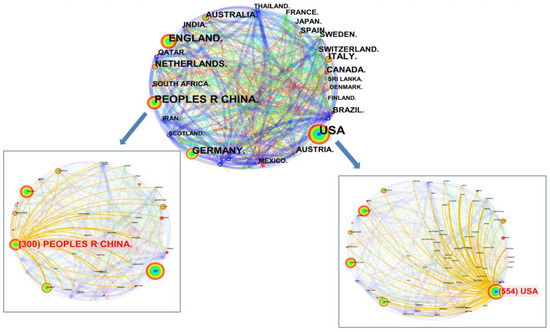
Figure 4.
Analysis of the national cooperative network.
2.5. Co-Occurrence Evolution in WEF Research
Keywords represent the core contents of research fields. Keyword co-occurrence analysis is used to explore the most critical research topics by analysing the frequency and temporal changes. Figure 5 shows the co-occurrence evolution process of WEF research. The size of the node represents the frequency of co-occurrence of the keyword, and the thickness of the line indicates the degree of relevance between the keywords. Different colours represent different years, the warmer the hue, the closer the year, and vice versa. For example, the keyword “climate change” is the largest node. Initially, “climate change” was highly correlated with “land use”. Subsequently, “climate change” appeared with “system” and “security” and occurred simultaneously. In recent years, “climate change” is always linked with “nexus” and “sustainability”, which indicates that climate change is now accompanied by integrating research and sustainability development.
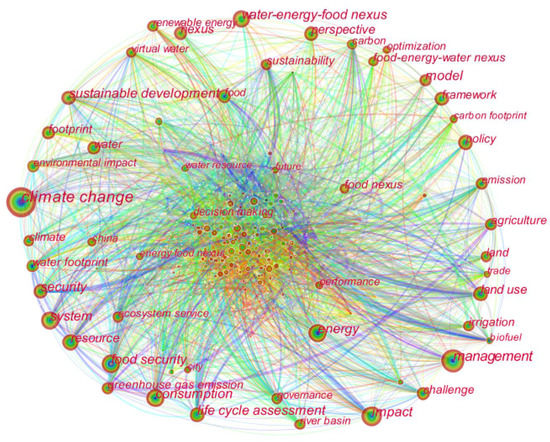
Figure 5.
Co-occurrence evolution progress.
It is clearly seen in Figure 5 that, “nexus” has attracted much more attention in recent researches. There are several nexus-related keywords, such as “nexus”, “water-energy-food nexus (WEF nexus)”, and “food-energy-water nexus”, mentioned in Figure 5. As WEF nexus has the highest amount and widest co-occurrence with the other keywords, 823 WEF-nexus-related studies will be discussed in the following sections.
3. Contents of WEF Nexus Research
3.1. Concept of WEF Nexus
The concept of the “WEF nexus” is shown in Figure 6. It highlights the inextricable interactions among the WEF sectors. It is clear that each of the three resources will affect the other in substantive ways.
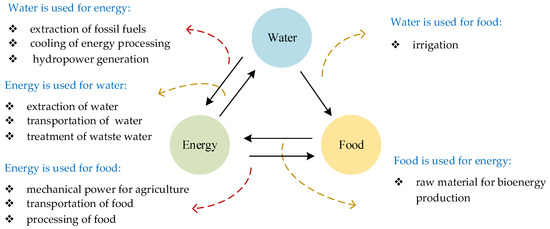
Figure 6.
Concept of WEF nexus.
Figure 7 shows the research contents of the WEF nexus. As shown in Figure 7, the research contents of the WEF nexus can be generally divided into three categories: internal, external, and integrated research. Internal researches mainly contain some cross-linking studies of a single W/E/F subsystem. Environmental factors such as carbon emission, livelihood, and geographic characteristics and so on are added to the WEF nexus and external researches are formed. Integration research is a brand-new branch of the WEF nexus. Here, water, energy, and food are combined as a whole, and some comprehensive investigations on the efficiency, sustainability, and security of the WEF nexus system are implemented.

Figure 7.
Research contents of the WEF nexus.
3.1.1. Internal Research of the WEF Nexus
The internal research on the WEF nexus in this study is understood as the interaction among water, energy, and food systems. Based on the above basic nexus, the internal research is arranged from three aspects: water and energy → food; water and food → energy; and energy → water.
- (1)
- Water and Energy → Food
Food consumes the most amount of water; therefore, it has the greatest impact on water and energy security [12]. It is necessary to select a feasible method to guarantee water and energy for food security [13]. As a result, some scholars made technical improvements to the water-distribution scheme in agricultural systems to reduce the overexploitation of groundwater and energy-related water pumping [14]. Additionally, the others tried to determine the optimum allocation of water and energy through an optimal model in the agricultural system, which could maximise the nutritional value of production [15].
Some scholars extend the definition of food from crops to meat, and the research content between WEF extends from production to the supply chain accordingly. With the transformation of the food system, the supply chain extends from rural to urban areas and from separate production to wholesale, processing, transport, and storage [16]. An American beef packaging plant has taken as an example to estimate the amount of water and energy consumed during its beef processing. The results showed that the slaughtering and cleaning processes consumed the most amount of water, and the refrigeration compressor system consumed the most energy [17].
Food transportation and sales also consume large amounts of water and energy. Further, the transportation process of food consumes water and energy directly [18,19]. At the sale stage, packaging and refrigeration processes increase the energy and water demand to extend the shelf life of food [20]. The lifecycle of food can help allocate water and energy resources more effectively and optimise the WEF nexus system.
- (2)
- Water and Food → Energy
The production of fossil fuels is closely related to that of water, and the production of bioenergy has a direct impact on food. Nearly 31% of the exploration areas for shale oil and shale gas are located in areas lacking water, and this proportion could increase to 44% in the future [21,22]. Additionally, the Rankine cycle of a thermal power plant consumes a large amount of water during cooling, which intensifies the correlation between energy and water consumption [23]. Some other scholars claimed that solar, wind, hydropower, waves, and tides can be used to generate electricity, which can avoid excessive water consumption and decouple the contradiction between energy and water systems [24]. On the other hand, Bonsch et al. [25] investigated the resource allocation of water and land to produce bioenergy to find a balance for production. He found that planting bioenergy crops for bioenergy production is likely to double the amount of water used in agriculture by 2095. Naess [26] investigated the bioenergy potentials from abandoned cropland and found that recently abandoned cropland could help meet 11–68% of today’s bioenergy demand.
- (3)
- Energy→Water
Energy is necessary to supply and treat wastewater. Li et al. [27] calculated the energy consumption of water supply and the results showed that water used for production in the water system directly consumed 87.18% of energy. Liu et al. [28] calculated the energy consumption of wastewater treatment; in the lifecycle of water, wastewater treatment consumes up to 30% of the total energy. Espinosa et al. [29] paid attention to the efficiency of water abstraction and energy consumption for irrigation in Spain from 1950 to 2017. He found that the water abstraction efficiency increased; however, the energy consumption also increased six-fold.
3.1.2. External Research of the WEF Nexus
External research on the WEF nexus is divided into several scales, such as carbon emission, livelihood, geographic characteristics, climate change, policy/law/rule, trade, new topics, etc.
- (1)
- Carbon emission
Carbon emissions are among the most important research topics in the WEF nexus. Ramaswami et al. [30] tried to analyse the WEF nexus under an urban system framework and found that agricultural food, with dominant milk, rice, and wheat, contributed to greenhouse gas emissions (GHG). Toboso et al. [31] developed the Roof Mosaic approach in the WEF nexus to protect the environment, showing that the application of this technology at the local scale can help reduce carbon emissions. Chamas et al. [32] brought the carbon cycle and its footprint into the WEF nexus framework and proposed the best resource allocation strategy through the optimisation model. He demonstrated that consuming fewer animal-based foods can drastically reduce land, water, and energy resources needed, and significantly cut CO2 emissions. Other scholars also claimed that the carbon emissions of animal-based diets (meat) are much higher than those of plant-based diets (fruit, vegetables, and beans) in household consumption [33].
- (2)
- Livelihood
Additionally, livelihood, which includes society, humanity, physics, ecology, and other elements, expands the conceptual framework of the WEF nexus [34,35]. Mabhaudhi et al. [36] proposed the improvement of rural livelihoods through proper planning, distribution, and resource management. Qi et al. [37] built a conceptual framework to determine the best ways to coordinate the WEF nexus in agricultural system production. The results showed that the attention and reform of rural livelihoods led to the extension of the farmland scale. In a word, an integrated model of the WEF nexus can be applied to comprehensively analyse the state of resources at the local level, which provided guidelines for improving the livelihoods of resource-poor rural communities [38].
- (3)
- Geographic characteristics
Research on the WEF nexus at the regional scale expands to a larger area, focusing on upstream and downstream specific watersheds [39,40], certain administrative divisions, and geographic blocks. Chen et al. [41] explored the water security condition and found that the upper-middle reaches of the Yangtze River perform better than those in the downstream regions. Allam et al. [42] identified the trade-off between upstream hydropower generation and downstream agricultural expansion. Simpson et al. [43] critically review the Mpumalanga Province through the lens of the WEF nexus to look for the existing or potential threats to water, energy, and food security in the provincial scale. Feng et al. [44] developed a physical input-output model for the FEW nexus to characterise the interdependence of the food, energy, and water systems in the Detroit Metropolitan Area.
- (4)
- Climate change
Climate change is also an important external factor affecting the WEF nexus through precipitation and temperature. Yang et al. [45] presented a new water system model for hydrological economics to verify that uncertain climate change leads to a deficient water supply for energy and food. Duan et al. [46] found that changes in temperature and precipitation decrease the runoff of the Amu Darya River and its tributaries, which may interrupt agricultural water supply and damage the amount of agricultural production.
- (5)
- Policy/Law/Rule
The application of policies under different national backgrounds is also an external factor guiding future development plans for the WEF nexus. Gain et al. [47] provided an emerging literature review on the WEF nexus and found that policy integration is strongly recommended to reduce conflicts over these resources. Subsequently, many scholars have proposed policy suggestions. For example, Arab finance green growth projects and the UK’s Brexit policy both have a potential impact on the WEF nexus [48,49]. Other policies have been dedicated to encourage individuals to reduce waste in food [50]. Meanwhile, improving the national legislation and rule level on WEF is important in promoting the WEF nexus [51]. Belinskij et al. [52] discussed whether international water laws improved the WEF nexus and Larcom [53] used a nexus case study to build a framework to obey the principle of justice, which emphasised the role of rule.
- (6)
- Trade
Trade links imports and exports from different regions. Countries can benefit from each other through trade activities. For example, Kuwait, Qatar, and Saudi Arabia are dominated by oil, and the value of food imports is 35 million barrels of oil equivalents, accounting for only 4% of the total economic benefits of oil exports in Kuwait. This phenomenon implied that these regions could compensate for the economic loss of dependence on food imports by exporting oil and natural gas [54]. Meanwhile, the rapid growth in trade between WEF will result in a massive virtual transfer of water and energy among regions [55]. Zhai et al. [56] adopted an environmental input-output analysis to quantify the inter-provincial water exchange and transfer embodied in the food trade. He found that many regions lacking water could suffer from more virtual water losses due to food exports, while some areas rich in water resources import food containing virtual water. Additionally, Vora et al. [57] built a network framework for food trade between different states and estimated the energy used for food irrigation and GHG embodied in trade. The data show that animal-based commodities have high carbon emissions, as the proportion in trade accounts for only 12%, but the embodied GHG emissions are as high as 38%. As a result, countries can reduce their GHGs by importing animal-based commodities through trade networks.
- (7)
- New topics
Recently, more scholars combined the WEF nexus with geopolitics [58]. For example, Hussein & Lambert [59] found that the geopolitical blockade imposed by neighbouring countries on Qatar has led Qatar to strive to produce food to achieve self-sufficiency. On the other hand, many projects such as hydropower development located in the border region are also complicated by a tangled geopolitical setting directly [60,61]. In addition, pandemics in some countries will bring new challenges to WEF nexus security. Al-Saidi et al. [62] take an analysis based on a case study (the Middle East) using national-scale insights to find how COVID-19 affects the WEF sector. The results suggested that COVID-19 directly affected the water sector, namely deteriorating water quality or higher water demand, and in consequence, energy demand for water. Under the pandemic, to control the spread of the disease, trade has been affected, mainly affecting the national food trade [63].
3.1.3. Integrated Research of the WEF Nexus
The comprehensive investigations on the efficiency, sustainability, and security of WEF allow for projections of future scenarios to be made and, in this sense, policies to mitigate deficiencies in all these sectors to be developed.
- (1)
- Efficiency
The high efficiency of input-output means that the WEF nexus system could combine less environmental cost and resource consumption to obtain greater output benefits. Some scholars developed an input-output evaluation system among WEF nexus systems to measure the coupling efficiency of the WEF nexus in different provinces in China and help find the key factors of coupling efficiency [64,65]. Huang et al. [66] used the data envelopment analysis (DEA) method and China’s provincial data to analyse the input-output efficiency of the WEF nexus by considering production-based intensity, consumption-based intensity, and the quantity index system. Ibrahim et al. [67] also built an input-output index system at a transnational level and evaluate the efficiency of WELF-Nexus using a robust order-αDEA model.
- (2)
- Sustainability
Many scholars have also built indicator systems to evaluate sustainability. To clarify the sustainability issues related to the WEF nexus, Yuan et al. [68] developed an indicator system and determined that renewable energy plays an essential role in the sustainability of the WEF nexus. Malago et al. [69] developed an analytical framework for investigating the impacts on sustainable development goals (SDGs) and also quantified the interconnection of nexus with SDGs. In addition, the optimisation of the nexus can also promote the overall sustainability of the WEF nexus. Cansino-Loeza et al. [70] presented a multi-objective optimization model that involves the sustainable production of water, energy, and food. Results showed that water reuse is crucial to improving the WEF nexus sustainability. Das et al. [71] also developed an optimal crop area allocation model based on a nexus-sustainability index for optimal water and energy uses.
- (3)
- Security
Cansino-Loeza et al. [72] presented an approach to assess the progress on the water-energy-food nexus security through an index that involves availability, accessibility, and sustainability indicators of a region over a time period. Purwanto et al. [73] developed a qualitative causal loop diagram of the water-energy-food security nexus in Indonesia, to elucidate to local stakeholders the complexity of the system. Li et al. [74] used the fuzzy comprehensive evaluation method to calculate the collaborative security index, which was the basis of the evaluation of the collaborative water-energy-food security in China.
3.2. Citation Burst Analysis in WEF Nexus Research
Citation burst is an indicator automatically calculated by CiteSpace. It represents a sudden frequency increase of a keyword in a certain period. Citation burst analysis is used to detect emerging dynamic concepts and potential hotspots in a field and is suitable for examining emerging trends and sudden changes in the development of disciplines, reflecting active or cutting-edge topics. It is commonly used for frontier analysis. Figure 8 shows the citation burst results since 2011. The time axis is represented by the light blue line and the burst keyword is represented by the red line. Keywords with high strength represent research frontiers in a certain period.
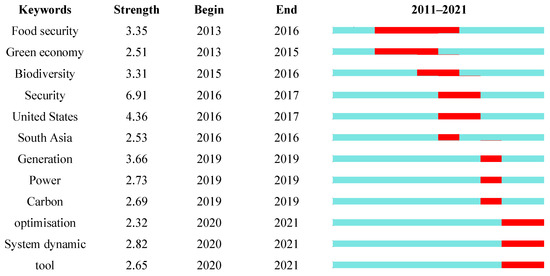
Figure 8.
Burst analysis of WEF nexus.
As shown in Figure 8, “security” is with the highest citation burst strength of 6.91, which is continued from 2016 to 2017. During this period, the research scale such as the “United States” and “South Asia” are also two important research frontiers focused on the regional analysis.
Furthermore, research methods have been a hot topic in the field of WEF nexus research in the past two years. “System dynamics (SD, 2.82)”, “Tool (2.65)”, and “Optimisation (2.32)” are the most important three bursts from 2020 to 2021. SD can be used to identify, quantify, and evaluate the key interlinkages among WEF [75]. When we come to the tools, they are mainly used to tackle the complexity of the WEF nexus. For example, the Nexus Tool 2.0 (Nexus Tool: http://wefnexustool.org/login.php accessed on 10 June 2022) is a web-based tool to quantify the flows of matter among water, energy, and food. On the other hand, the Water Evaluation and Planning System (WEAP) (WEAP: https://www.weap21.org/ accessed on 10 June 2022) is a modelling tool, which incorporates water quality, ecosystem preservation, and protection values, and so on into a water resource planning and policy analysis. Last but not the least, increasing demand and decreasing supplies have become conflict issues in major global resources, balancing such conflicts calls for more advanced optimisation models. The complexity and conflict among the WEF nexus make the optimisation method play a huge role at present and in the future [76].
3.3. Knowledge Cluster Analysis in WEF Nexus Research
The knowledge cluster analysis is conducted on the basis of keyword co-occurrence of WEF nexus. The area of each cluster is composed of related nodes, representing different subjects and characteristics of the WEF nexus. In Figure 9, the clusters are ordered from 0 to 17: the smaller the number, the more keywords included.
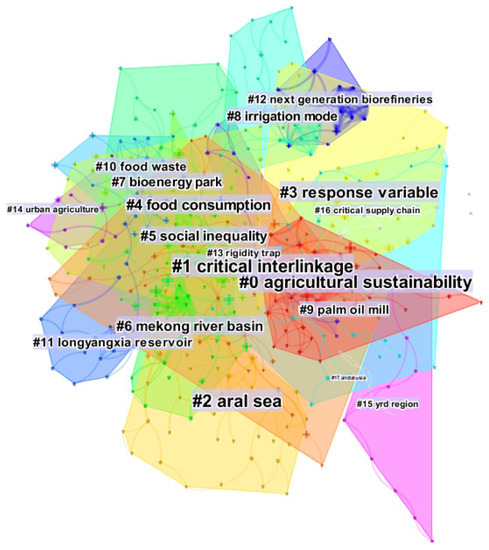
Figure 9.
Knowledge clusters analysis of cited reference.
According to Figure 9, the main research topics are collected in Table 1. There are also some knowledge clusters with small areas; however, due to space limitations, they are not mentioned in Table 1.

Table 1.
The description of knowledge clusters (selected).
4. Methods of WEF Nexus Research
WEF nexus research methods can be divided into qualitative and quantitative methods [88]. Qualitative methods focus on framework construction and descriptive analysis, while quantitative methods are used for quantification, prediction, evaluation, and optimisation. As shown in Figure 10, scholars tend to use qualitative analysis at the beginning of their studies. During the past three years (from 2019 to 2021), quantitative methods have gradually surpassed qualitative ones. This means that an increasing number of institutions and scholars have focused on the mathematical methods of the WEF nexus.
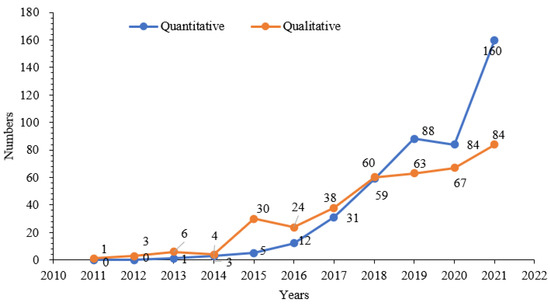
Figure 10.
Comparison of quantitative and qualitative methods.
4.1. Qualitative Methods
The qualitative methods are mainly used to identify the definition and interaction mechanism of the WEF nexus. Some researchers identify the WEF nexus by establishing comprehensive frameworks [89,90]. Scholars try to establish WEF nexus systems through expert interviews [91,92]. A questionnaire survey [93,94] is also one of the methods used to build a nexus framework. There are also some researchers [95,96] committed to determining the connotation of WEF nexus and defining the boundary of nexus with indicator research. In addition, Chen et al. [97,98] tried to clarify the development process of the WEF nexus, and Bromwich et al. [99,100] proposed the development strategy of the WEF nexus through a case study. Marttunen et al. [101] provided enlightenments for some regions through the new conceptual framework on the WEF nexus.
4.2. Quantitative Methods
As shown in Figure 11, the quantitative methods for the WEF nexus can be divided into two categories: (1) calculation and prediction, and (2) evaluation and optimisation. Calculation and prediction studies focus on the consumption of WEF systems and their environmental influences [102,103,104,105,106,107,108,109,110,111]. Evaluation and optimisation research evaluates the development of WEF and seek the best scheme for managing WEF through optimisation models [112,113,114,115,116].
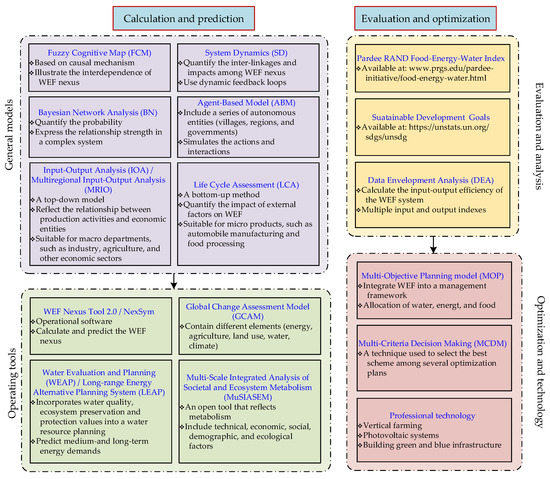
Figure 11.
Quantitative methods in WEF nexus.
5. Conclusions and Prospects
This study uses “water, energy, food” as the retrieval keyword in the WoS database. CiteSpace was used to visualise the bibliometric results. CiteSpace shows that the WEF nexus is a hot topic in current research. In this case, the research contents and methods in the WEF nexus are discussed further and the conclusions are as follows.
Research on WEF increased in 2010, and the growth rate accelerated significantly after 2015. The total number of papers published by the United States maintained a leading position, followed by China and the United Kingdom. FAO, Hoff, and Bazilian are the most influential authors, and all of them proposed to ponder WEF from the perspective of the WEF nexus. Institutions such as the Chinese Academy of Sciences, Beijing Normal University, and the University of Texas are among the top three institutions in WEF research.
With respect to the evolution of WEF research, an increasing number of scholars have conducted interdisciplinary research, especially the WEF nexus-related researches. Knowledge clusters analysis results show that “agricultural sustainability”, “critical interlinkage”, and “river basin” are the most important research fields in the research period. The frontiers of the WEF nexus have gradually changed into methods of investigation.
Although scholars have conducted in-depth and extensive researches on the WEF nexus, there are still some new issues that have not received enough attention relative to their potential importance, such as the relationship between the WEF nexus and wars, pandemics, and geopolitics. Furthermore, the lack of a data support platform also limits the research span on the WEF nexus across fields and departments. Comprehensive data platform construction for inter-department of water, energy, and food subsystems may also become a hot topic in the near future.
Author Contributions
Conceptualisation, J.W. and K.J.; Software, J.W.; Writing—Original Draft Preparation, J.W.; Writing—Review and Editing, K.J.; Visualisation, J.W.; Supervision, K.J. and X.W.; Funding Acquisition, K.J. and X.W. All authors have read and agreed to the published version of the manuscript.
Funding
This work was supported by the General programs of the National Natural Science Foundation of China [grant number 71874073]; Six talent peaks projects in Jiangsu Province [grant number JNHB-024]; International Clean Energy Top Talents Program (iCET 2018) funded by China Scholarship Council (CSC); Young and middle-aged academic leaders of Qinglan Project in Jiangsu Province; and Deep-Blue Scholar program funded by Jiangsu University of Science and Technology; 2021 Major Project of Philosophy and Social Sciences of Jiangsu Universities [grant number 2021SJZDA169]; 2021 Special Key Project of “Teaching and Research” for Jiangsu Universities of Jiangsu Association of Higher Education [grant number 2021JSJY007]; Higher Education Scientific Research Project Approval Topic of Jiangsu University of Science and Technology (Continuing Education Project, GJKTYBJX202005); and Postgraduate Research & Practice Innovation Program of Jiangsu Province [grant numbers KYCX22_3738; KYCX21_3428].
Institutional Review Board Statement
Not applicable.
Informed Consent Statement
Not applicable.
Data Availability Statement
Data available in a publicly accessible repository. The data presented in this study are openly available in the Web of Science database by using “water, energy, food” as the retrieval keyword from 2006 to 2021.
Conflicts of Interest
The authors declare that they have no known competing financial interest or personal relationships that could have appeared to influence the work reported in this paper.
References
- Hartfiel, L.; Soupir, M.; Kanwar, R.S. Malta’s Water Scarcity Challenges: Past, Present, and Future Mitigation Strategies for Sustainable Water Supplies. Sustainability 2020, 12, 9835. [Google Scholar] [CrossRef]
- Chaudhuri, S.; Roy, M.; McDonald, L.M.; Emendack, Y. Reflections on farmers’ social networks: A means for sustainable agricultural development? Environ. Dev. Sustain. 2021, 23, 2973–3008. [Google Scholar] [CrossRef]
- Liu, J.; Mooney, H.; Hull, V.; Davis, S.J.; Gaskell, J.; Hertel, T.; Lubchenco, J.; Seto, K.C.; Gleick, P.; Kremen, C.; et al. Systems integration for global sustainability. Science 2015, 347, 1258832. [Google Scholar] [CrossRef] [Green Version]
- Hoff, H. Global water resources and their management. Curr. Opin. Environ. Sustain. 2009, 1, 141–147. [Google Scholar] [CrossRef]
- Hoff, H.; Falkenmark, M.; Gerten, D.; Gordon, L.; Karlberg, L.; Rockström, J. Greening the global water system. J. Hydrol. 2010, 384, 177–186. [Google Scholar] [CrossRef]
- Bazilian, M.; Rogner, H.; Howells, M.; Hermann, S.; Arent, D.; Gielen, D.; Steduto, P.; Mueller, A.; Komor, P.; Tol, R.S.J.; et al. Considering the energy, water and food nexus: Towards an integrated modelling approach. Energy Policy 2011, 39, 7896–7906. [Google Scholar] [CrossRef]
- Bazilian, M.; Nussbaumer, P.; Rogner, H.-H.; Brew-Hammond, A.; Foster, V.; Pachauri, S.; Williams, E.; Howells, M.; Niyongabo, P.; Musaba, L.; et al. Energy access scenarios to 2030 for the power sector in sub-Saharan Africa. Util. Policy 2012, 20, 1–16. [Google Scholar] [CrossRef] [Green Version]
- Hoekstra, A.Y.; Chapagain, A.K. Water footprints of nations: Water use by people as a function of their consumption pattern. Water Resour. Manag. 2007, 21, 35–48. [Google Scholar] [CrossRef]
- Hoekstra, A.Y.; Mekonnen, M.M. The water footprint of humanity. Proc. Natl. Acad. Sci. USA 2012, 109, 3232–3237. [Google Scholar] [CrossRef] [Green Version]
- Rasul, G. Food, water, and energy security in South Asia: A nexus perspective from the Hindu Kush Himalayan region. Environ. Sci. Policy 2014, 39, 35–48. [Google Scholar] [CrossRef] [Green Version]
- Endo, A.; Tsurita, I.; Burnett, K.; Orencio, P.M. A review of the current state of research on the water, energy, and food nexus. J. Hydrol. Reg. Stud. 2017, 11, 20–30. [Google Scholar] [CrossRef] [Green Version]
- Li, M.; Singh, V.P.; Fu, Q.; Liu, D.; Li, T.; Zhou, Y. Optimization of agricultural water–food–energy nexus in a random environment: An integrated modelling approach. Stoch. Environ. Res. Risk Assess. 2021, 35, 3–19. [Google Scholar] [CrossRef]
- Gathala, M.K.; Laing, A.M.; Tiwari, T.P.; Timsina, J.; Islam, M.S.; Chowdhury, A.K.; Chattopadhyay, C.; Singh, A.K.; Bhatt, B.P.; Shrestha, R.; et al. Enabling smallholder farmers to sustainably improve their food, energy and water nexus while achieving environmental and economic benefits. Renew. Sustain. Energy Rev. 2020, 120, 109645. [Google Scholar] [CrossRef]
- Kamrani, K.; Roozbahani, A.; Shahdany, S.M.H. Using Bayesian networks to evaluate how agricultural water distribution systems handle the water-food-energy nexus. Agric. Water Manag. 2020, 239, 106265. [Google Scholar] [CrossRef]
- Al-Thani, N.A.; Govindan, R.; Al-Ansari, T. Maximising nutritional benefits within the energy, water and food nexus. J. Clean. Prod. 2020, 266, 121877. [Google Scholar] [CrossRef]
- Song, F.; Reardon, T.; Tian, X.; Lin, C. The energy implication of China’s food system transformation. Appl. Energy 2019, 240, 617–629. [Google Scholar] [CrossRef]
- Li, S.; Ziara, R.M.M.; Dvorak, B.; Subbiah, J. Assessment of water and energy use at process level in the U.S. beef packing industry: Case study in a typical U.S. large-size plant. J. Food Process Eng. 2018, 41, e12919. [Google Scholar] [CrossRef]
- Zimmerman, R.; Zhu, Q.; Dimitri, C. A network framework for dynamic models of urban food, energy and water systems (FEWS). Environ. Prog. Sustain. Energy 2018, 37, 122–131. [Google Scholar] [CrossRef]
- Pagani, M.; De Menna, F.; Johnson, T.G.; Vittuari, M. Impacts and costs of embodied and nutritional energy of food losses in the US food system: Farming and processing (Part A). J. Clean. Prod. 2020, 244, 118730. [Google Scholar] [CrossRef]
- Vittuari, M.; Pagani, M.; Johnson, T.G.; De Menna, F. Impacts and costs of embodied and nutritional energy of food waste in the US food system: Distribution and consumption (Part B). J. Clean. Prod. 2020, 252, 119857. [Google Scholar] [CrossRef]
- Rosa, L.; Rulli, M.C.; Davis, K.F.; D’Odorico, P. The Water-Energy Nexus of Hydraulic Fracturing: A Global Hydrologic Analysis for Shale Oil and Gas Extraction. Earth’s Futur. 2018, 6, 745–756. [Google Scholar] [CrossRef] [Green Version]
- Uen, T.-S.; Chang, F.-J.; Zhou, Y.; Tsai, W.-P. Exploring synergistic benefits of Water-Food-Energy Nexus through multi-objective reservoir optimization schemes. Sci. Total Environ. 2018, 633, 341–351. [Google Scholar] [CrossRef] [PubMed]
- Wong, K.V. Energy-Water-Food Nexus and Recommendations for Security. J. Energy Resour. Technol.-Trans. ASME 2015, 137, 34701. [Google Scholar] [CrossRef]
- Neto, R.D.S.; Berchin, I.I.; Magtoto, M.; Berchin, S.; Xavier, W.G.; Guerra, J. An integrative approach for the water-energy-food nexus in beef cattle production: A simulation of the proposed model to Brazil. J. Clean. Prod. 2018, 204, 1108–1123. [Google Scholar] [CrossRef]
- Bonsch, M.; Humpenöder, F.; Popp, A.; Bodirsky, B.L.; Dietrich, J.P.; Rolinski, S.; Biewald, A.; Lotze-Campen, H.; Weindl, I.; Gerten, D.; et al. Trade-offs between land and water requirements for large-scale bioenergy production. Glob. Chang. Biol. Bioenergy 2016, 8, 11–24. [Google Scholar] [CrossRef]
- Næss, J.S.; Cavalett, O.; Cherubini, F. The land–energy–water nexus of global bioenergy potentials from abandoned cropland. Nat. Sustain. 2021, 4, 525–536. [Google Scholar] [CrossRef]
- Li, P.C.; Ma, H.W. Evaluating the environmental impacts of the water-energy-food nexus with a life-cycle approach. Resour. Conserv. Recycl. 2020, 157, 104789. [Google Scholar] [CrossRef]
- Liu, D.; Guo, S.; Liu, P.; Xiong, L.; Zou, H.; Tian, J.; Zeng, Y.; Shen, Y.; Zhang, J. Optimisation of water-energy nexus based on its diagram in cascade reservoir system. J. Hydrol. 2019, 569, 347–358. [Google Scholar] [CrossRef]
- Espinosa-Tasón, J.; Berbel, J.; Gutiérrez-Martín, C. Energized water: Evolution of water-energy nexus in the Spanish irrigated agriculture, 1950–2017. Agric. Water Manag. 2020, 233, 106073. [Google Scholar] [CrossRef]
- Ramaswami, A.; Boyer, D.; Nagpure, A.S.; Fang, A.; Bogra, S.; Bakshi, B.; Cohen, E.; Rao-Ghorpade, A. An urban systems framework to assess the trans-boundary food-energy-water nexus: Implementation in Delhi, India. Environ. Res. Lett. 2017, 12, 25008. [Google Scholar] [CrossRef] [Green Version]
- Toboso-Chavero, S.; Nadal, A.; Petit-Boix, A.; Pons, O.; Villalba, G.; Gabarrell, X.; Josa, A.; Rieradevall, J. Towards Productive Cities: Environmental Assessment of the Food-Energy-Water Nexus of the Urban Roof Mosaic. J. Ind. Ecol. 2019, 23, 767–780. [Google Scholar] [CrossRef] [PubMed] [Green Version]
- Chamas, Z.; Abou Najm, M.; Al-Hindi, M.; Yassine, A.; Khattar, R. Sustainable resource optimization under water-energy-food-carbon nexus. J. Clean. Prod. 2021, 278, 123894. [Google Scholar] [CrossRef]
- He, G.; Geng, C.; Zhai, J.; Zhao, Y.; Wang, Q.; Jiang, S.; Zhu, Y.; Wang, L. Impact of food consumption patterns change on agricultural water requirements: An urban-rural comparison in China. Agric. Water Manag. 2021, 243, 106504. [Google Scholar] [CrossRef]
- Biggs, E.M.; Bruce, E.; Boruff, B.; Duncan, J.M.A.; Horsley, J.; Pauli, N.; McNeill, K.; Neef, A.; Van Ogtrop, F.; Curnow, J.; et al. Sustainable development and the water–energy–food nexus: A perspective on livelihoods. Environ. Sci. Policy 2015, 54, 389–397. [Google Scholar] [CrossRef] [Green Version]
- Wolde, Z.; Wei, W.; Kunpeng, W.; Ketema, H. Local community perceptions toward livelihood and water–energy–food nexus: A perspective on food security. Food Energy Secur. 2020, 9, e207. [Google Scholar] [CrossRef]
- Mabhaudhi, T.; Nhamo, L.; Mpandeli, S.; Nhemachena, C.; Senzanje, A.; Sobratee, N.; Chivenge, P.P.; Slotow, R.; Naidoo, D.; Liphadzi, S.; et al. The Water–Energy–Food Nexus as a Tool to Transform Rural Livelihoods and Well-Being in Southern Africa. Int. J. Environ. Res. Public Health 2019, 16, 2970. [Google Scholar] [CrossRef] [Green Version]
- Qi, X.; Li, J.; Yuan, W.; Wang, R.Y. Coordinating the food-energy-water nexus in grain production in the context of rural livelihood transitions and farmland resource constraints. Resour. Conserv. Recycl. 2021, 164, 105148. [Google Scholar] [CrossRef]
- Nhamo, L.; Ndlela, B.; Mpandeli, S.; Mabhaudhi, T. The Water-Energy-Food Nexus as an Adaptation Strategy for Achieving Sustainable Livelihoods at a Local Level. Sustainability 2020, 12, 8582. [Google Scholar] [CrossRef]
- Liang, S.; Qu, S.; Zhao, Q.; Zhang, X.; Daigger, G.T.; Newell, J.P.; Miller, S.A.; Johnson, J.X.; Love, N.G.; Zhang, L.; et al. Quantifying the Urban Food–Energy–Water Nexus: The Case of the Detroit Metropolitan Area. Environ. Sci. Technol. 2019, 53, 779–788. [Google Scholar] [CrossRef]
- Liu, Z.; Huang, Q.; He, C.; Wang, C.; Wang, Y.; Li, K. Water-energy nexus within urban agglomeration: An assessment framework combining the multiregional input-output model, virtual water, and embodied energy. Resour. Conserv. Recycl. 2021, 164, 105113. [Google Scholar] [CrossRef]
- Chen, W.; Chen, Y. Pre-Warning Measurement of Water Resources Security in the Yangtze River Basin from the Perspective of Water-Energy-Food Symbiosis. Water 2021, 13, 475. [Google Scholar] [CrossRef]
- Allam, M.M.; Eltahir, E.A.B. Water-Energy-Food Nexus Sustainability in the Upper Blue Nile (UBN) Basin. Front. Environ. Sci. 2019, 7, 5. [Google Scholar] [CrossRef] [Green Version]
- Simpson, G.B.; Badenhorst, J.; Jewitt, G.P.W.; Berchner, M.; Davies, E. Competition for Land: The Water-Energy-Food Nexus and Coal Mining in Mpumalanga Province, South Africa. Front. Environ. Sci. 2019, 7, 86. [Google Scholar] [CrossRef]
- Feng, C.; Qu, S.; Jin, Y.; Tang, X.; Liang, S.; Chiu, A.S.F.; Xu, M. Uncovering urban food-energy-water nexus based on physical input-output analysis: The case of the Detroit Metropolitan Area. Appl. Energy 2019, 252, 113422. [Google Scholar] [CrossRef]
- Yang, Y.C.E.; Wi, S.; Ray, P.A.; Brown, C.M.; Khalil, A.F. The future nexus of the Brahmaputra River Basin: Climate, water, energy and food trajectories. Glob. Environ. Chang. -Hum. Policy Dimens. 2016, 37, 16–30. [Google Scholar] [CrossRef] [Green Version]
- Duan, W.; Chen, Y.; Zou, S.; Nover, D. Managing the water-climate- food nexus for sustainable development in Turkmenistan. J. Clean. Prod. 2019, 220, 212–224. [Google Scholar] [CrossRef]
- Gain, A.K.; Giupponi, C.; Benson, D. The water–energy–food (WEF) security nexus: The policy perspective of Bangladesh. Water Int. 2015, 40, 895–910. [Google Scholar] [CrossRef] [Green Version]
- Keulertz, M.; Woertz, E. Financial challenges of the nexus: Pathways for investment in water, energy and agriculture in the Arab world. Int. J. Water Resour. Dev. 2015, 31, 312–325. [Google Scholar] [CrossRef]
- Ziv, G.; Watson, E.; Young, D.; Howard, D.C.; Larcom, S.T.; Tanentzap, A.J. The potential impact of Brexit on the energy, water and food nexus in the UK: A fuzzy cognitive mapping approach. Appl. Energy 2018, 210, 487–498. [Google Scholar] [CrossRef]
- Hannibal, B.; Vedlitz, A. Throwing it out: Introducing a nexus perspective in examining citizen perceptions of organizational food waste in the U.S. Environ. Sci. Policy 2018, 88, 63–71. [Google Scholar] [CrossRef]
- Olawuyi, D. Sustainable development and the water-energy-food nexus: Legal challenges and emerging solutions. Environ. Sci. Policy 2020, 103, 1–9. [Google Scholar] [CrossRef]
- Belinskij, A. Water-Energy-Food Nexus within the Framework of International Water Law. Water 2015, 7, 5396–5415. [Google Scholar] [CrossRef] [Green Version]
- Larcom, S.; van Gevelt, T. Regulating the water-energy-food nexus: Interdependencies, transaction costs and procedural justice. Environ. Sci. Policy 2017, 72, 55–64. [Google Scholar] [CrossRef]
- Siderius, C.; Conway, D.; Yassine, M.; Murken, L.; Lostis, P.-L.; Dalin, C. Multi-scale analysis of the water-energy-food nexus in the Gulf region. Environ. Res. Lett. 2020, 15, 94024. [Google Scholar] [CrossRef]
- D’Odorico, P.; Davis, K.F.; Rosa, L.; Carr, J.A.; Chiarelli, D.; Dell’Angelo, J.; Gephart, J.; MacDonald, G.K.; Seekell, D.A.; Suweis, S.; et al. The Global Food-Energy-Water Nexus. Rev. Geophys. 2018, 56, 456–531. [Google Scholar] [CrossRef]
- Zhai, M.; Huang, G.; Liu, L.; Xu, X.; Li, J. Transfer of virtual water embodied in food: A new perspective. Sci. Total Environ. 2019, 659, 872–883. [Google Scholar] [CrossRef]
- Vora, N.; Shah, A.; Bilec, M.M.; Khanna, V. Food–Energy–Water Nexus: Quantifying Embodied Energy and GHG Emissions from Irrigation through Virtual Water Transfers in Food Trade. ACS Sustain. Chem. Eng. 2017, 5, 2119–2128. [Google Scholar] [CrossRef]
- Allouche, J.; Middleton, C.; Gyawali, D. Technical Veil, Hidden Politics: Interrogating the Power Linkages behind the Nexus. Water Altern. -Interdiscip. J. Water Politics Dev. 2015, 8, 610–626. [Google Scholar]
- Hussein, H.; Lambert, L.A. A Rentier State under Blockade: Qatar’s Water-Energy-Food Predicament from Energy Abundance and Food Insecurity to a Silent Water Crisis. Water 2020, 12, 1051. [Google Scholar] [CrossRef] [Green Version]
- Hennig, T.; Wang, W.; Magee, D.; He, D. Yunnan’s Fast-Paced Large Hydropower Development: A Powershed-Based Approach to Critically Assessing Generation and Consumption Paradigms. Water 2016, 8, 476. [Google Scholar] [CrossRef]
- Hennig, T. Damming the transnational Ayeyarwady basin. Hydropower and the water-energy nexus. Renew. Sustain. Energy Rev. 2016, 65, 1232–1246. [Google Scholar] [CrossRef]
- Al-Saidi, M.; Hussein, H. The water-energy-food nexus and COVID-19: Towards a systematization of impacts and responses. Sci. Total Environ. 2021, 779, 146529. [Google Scholar] [CrossRef] [PubMed]
- Zhao, N.; You, F. Food-energy-water-waste nexus systems optimization for New York State under the COVID-19 pandemic to alleviate health and environmental concerns. Appl. Energy 2021, 282, 116181. [Google Scholar] [CrossRef]
- Zhang, T.M.; Xu, Y.J. Evaluation on the Efficiency of Water-Energy-Food Nexus Based on Data Envelopment Analysis (DEA) and Malmquist in Different Regions of China. Int. J. Comput. Intell. Syst. 2019, 12, 1649–1659. [Google Scholar] [CrossRef]
- Sun, C.; Yan, X.; Zhao, L. Coupling efficiency measurement and spatial correlation characteristic of water–energy–food nexus in China. Resour. Conserv. Recycl. 2021, 164, 105151. [Google Scholar] [CrossRef]
- Huang, D.; Shen, Z.; Sun, C.; Li, G. Shifting from Production-Based to Consumption-Based Nexus Governance: Evidence from an Input–Output Analysis of the Local Water-Energy-Food Nexus. Water Resour. Manag. 2021, 35, 1673–1688. [Google Scholar] [CrossRef]
- Ibrahim, M.D.; Ferreira, D.C.; Daneshvar, S.; Marques, R.C. Transnational resource generativity: Efficiency analysis and target setting of water, energy, land, and food nexus for OECD countries. Sci. Total Environ. 2019, 697, 134017. [Google Scholar] [CrossRef] [PubMed]
- Yuan, M.-H.; Chiueh, P.-T.; Lo, S.-L. Measuring urban food-energy-water nexus sustainability: Finding solutions for cities. Sci. Total Environ. 2021, 752, 141954. [Google Scholar] [CrossRef]
- Malagó, A.; Comero, S.; Bouraoui, F.; Kazezyılmaz-Alhan, C.M.; Gawlik, B.M.; Easton, P.; Laspidou, C. An analytical framework to assess SDG targets within the context of WEFE nexus in the Mediterranean region. Resour. Conserv. Recycl. 2021, 164, 105205. [Google Scholar] [CrossRef]
- Cansino-Loeza, B.; Ponce-Ortega, J.M. Sustainable assessment of Water-Energy-Food Nexus at regional level through a multi-stakeholder optimization approach. J. Clean. Prod. 2021, 290, 125194. [Google Scholar] [CrossRef]
- Das, A.; Sahoo, B.; Panda, S.N. Evaluation of Nexus-Sustainability and Conventional Approaches for Optimal Water-Energy-Land-Crop Planning in an Irrigated Canal Command. Water Resour. Manag. 2020, 34, 2329–2351. [Google Scholar] [CrossRef]
- Cansino-Loeza, B.; Sánchez-Zarco, X.G.; Mora-Jacobo, E.G.; Saggiante-Mauro, F.E.; González-Bravo, R.; Mahlknecht, J.; Ponce-Ortega, J.M. Systematic Approach for Assessing the Water–Energy–Food Nexus for Sustainable Development in Regions with Resource Scarcities. ACS Sustain. Chem. Eng. 2020, 8, 13734–13748. [Google Scholar] [CrossRef]
- Purwanto, A.; Sušnik, J.; Suryadi, F.; de Fraiture, C. Using group model building to develop a causal loop mapping of the water-energy-food security nexus in Karawang Regency, Indonesia. J. Clean. Prod. 2019, 240, 118170. [Google Scholar] [CrossRef]
- Li, X.; Liu, C.; Wang, G.; Bao, Z.; Diao, Y.; Liu, J. Evaluating the Collaborative Security of Water–Energy–Food in China on the Basis of Symbiotic System Theory. Water 2021, 13, 1112. [Google Scholar] [CrossRef]
- González-Rosell, A.; Blanco, M.; Arfa, I. Integrating Stakeholder Views and System Dynamics to Assess the Water–Energy–Food Nexus in Andalusia. Water 2020, 12, 3172. [Google Scholar] [CrossRef]
- Zhang, T.; Tan, Q.; Yu, X.; Zhang, S. Synergy assessment and optimization for water-energy-food nexus: Modeling and application. Renew. Sustain. Energy Rev. 2020, 134, 110059. [Google Scholar] [CrossRef]
- Siciliano, G.; Rulli, M.C.; D’Odorico, P. European large-scale farmland investments and the land-water-energy-food nexus. Adv. Water Resour. 2017, 110, 579–590. [Google Scholar] [CrossRef] [Green Version]
- El-Gafy, I.; Grigg, N.; Waskom, R. Water-Food-Energy: Nexus and Non-Nexus Approaches for Optimal Cropping Pattern. Water Resour. Manag. 2017, 31, 4971–4980. [Google Scholar] [CrossRef]
- Al-Saidi, M.; Elagib, N.A. Towards understanding the integrative approach of the water, energy and food nexus. Sci. Total Environ. 2017, 574, 1131–1139. [Google Scholar] [CrossRef]
- Zhou, Y.; Chang, L.-C.; Uen, T.-S.; Guo, S.; Xu, C.-Y.; Chang, F.-J. Prospect for small-hydropower installation settled upon optimal water allocation: An action to stimulate synergies of water-food-energy nexus. Appl. Energy 2019, 238, 668–682. [Google Scholar] [CrossRef]
- Gao, J.Y.; Zhao, J.S.; Wang, H. Dam-Impacted Water-Energy-Food Nexus in Lancang-Mekong River Basin. J. Water Resour. Plan. Manag. 2021, 147, 4021010. [Google Scholar] [CrossRef]
- Basheer, M.; Wheeler, K.G.; Ribbe, L.; Majdalawi, M.; Abdo, G.; Zagona, E.A. Quantifying and evaluating the impacts of cooperation in transboundary river basins on the Water-Energy-Food nexus: The Blue Nile Basin. Sci. Total Environ. 2018, 630, 1309–1323. [Google Scholar] [CrossRef] [PubMed]
- Gragg, R.S.; Anandhi, A.; Jiru, M.; Usher, K.M. A Conceptualization of the Urban Food-Energy-Water Nexus Sustainability Paradigm: Modeling From Theory to Practice. Front. Environ. Sci. 2018, 6, 133. [Google Scholar] [CrossRef]
- Qian, X.-Y.; Liang, Q.-M. Sustainability evaluation of the provincial water-energy-food nexus in China: Evolutions, obstacles, and response strategies. Sustain. Cities Soc. 2021, 75, 103332. [Google Scholar] [CrossRef]
- de Melo, T.G.; de Souza, B.L.; Scopinho, R.A. Peri-urban territories and WEF nexus: The challenges of Brazilian agrarian reform areas for social justice. J. Integr. Environ. Sci. 2020, 17, 45–67. [Google Scholar] [CrossRef]
- Benjamin, M.F.D.; Andiappan, V.; Lee, J.-Y.; Tan, R.R. Increasing the reliability of bioenergy parks utilizing agricultural waste feedstock under demand uncertainty. J. Clean. Prod. 2020, 269, 122385. [Google Scholar] [CrossRef]
- Jaroenkietkajorn, U.; Gheewala, S.H. Interlinkage between water-energy-food for oil palm cultivation in Thailand. Sustain. Prod. Consum. 2020, 22, 205–217. [Google Scholar] [CrossRef]
- Endo, A.; Burnett, K.; Orencio, P.M.; Kumazawa, T.; Wada, C.A.; Ishii, A.; Tsurita, I.; Taniguchi, M. Methods of the Water-Energy-Food Nexus. Water 2015, 7, 5806–5830. [Google Scholar] [CrossRef] [Green Version]
- Rasul, G. Managing the food, water, and energy nexus for achieving the Sustainable Development Goals in South Asia. Environ. Dev. 2016, 18, 14–25. [Google Scholar] [CrossRef] [Green Version]
- Mayor, B.; López-Gunn, E.; Villarroya, F.I.; Montero, E. Application of a water–energy–food nexus framework for the Duero river basin in Spain. Water Int. 2015, 40, 791–808. [Google Scholar] [CrossRef]
- Al-Saidi, M.; Hefny, A. Institutional arrangements for beneficial regional cooperation on water, energy and food priority issues in the Eastern Nile Basin. J. Hydrol. 2018, 562, 821–831. [Google Scholar] [CrossRef]
- Green, J.M.H.; Cranston, G.R.; Sutherland, W.J.; Tranter, H.R.; Bell, S.J.; Benton, T.G.; Blixt, E.; Bowe, C.; Broadley, S.; Brown, A.; et al. Research priorities for managing the impacts and dependencies of business upon food, energy, water and the environment. Sustain. Sci. 2017, 12, 319–331. [Google Scholar] [CrossRef] [PubMed] [Green Version]
- Steel, B.S.; Wolters, E.A.; Warner, R.L. Public Preferences for Food-Energy-Water Tradeoffs in the Western US. Sustainability 2019, 11, 5200. [Google Scholar] [CrossRef] [Green Version]
- Gebreyes, M.; Bazzana, D.; Simonetto, A.; Müller-Mahn, D.; Zaitchik, B.; Gilioli, G.; Simane, B. Local Perceptions of Water-Energy-Food Security: Livelihood Consequences of Dam Construction in Ethiopia. Sustainability 2020, 12, 2161. [Google Scholar] [CrossRef] [Green Version]
- Urbinatti, A.M.; Dalla Fontana, M.; Stirling, A.; Giatti, L.L. ‘Opening up’ the governance of water-energy-food nexus: Towards a science-policy-society interface based on hybridity and humility. Sci. Total Environ. 2020, 744, 140945. [Google Scholar] [CrossRef]
- Nhamo, L.; Ndlela, B.; Nhemachena, C.; Mabhaudhi, T.; Mpandeli, S.; Matchaya, G. The Water-Energy-Food Nexus: Climate Risks and Opportunities in Southern Africa. Water 2018, 10, 567. [Google Scholar] [CrossRef] [Green Version]
- Chen, D.; Zhang, P.; Luo, Z.; Zhang, D.; Bi, B.; Cao, X. Recent Progress on the Water–Energy–Food Nexus using Bibliometric Analysis. Curr. Sci. 2019, 117, 577–586. [Google Scholar] [CrossRef]
- De Andrade Guerra, J.B.S.O.; Berchin, I.I.; Garcia, J.; da Silva Neiva, S.; Jonck, A.V.; Faraco, R.A.; de Amorim, W.S.; Ribeiro, J.M.P. A literature-based study on the water-energy-food nexus for sustainable development. Stoch. Environ. Res. Risk Assess. 2021, 35, 95–116. [Google Scholar] [CrossRef]
- Bromwich, B. Nexus meets crisis: A review of conflict, natural resources and the humanitarian response in Darfur with reference to the water-energy-food nexus. Int. J. Water Resour. Dev. 2015, 31, 375–392. [Google Scholar] [CrossRef]
- Pahl-Wostl, C. Governance of the water-energy-food security nexus: A multi-level coordination challenge. Environ. Sci. Policy 2019, 92, 356–367. [Google Scholar] [CrossRef]
- Marttunen, M.; Mustajoki, J.; Sojamo, S.; Ahopelto, L.; Keskinen, M. A Framework for Assessing Water Security and the Water-Energy-Food NexusThe Case of Finland. Sustainability 2019, 11, 2900. [Google Scholar] [CrossRef] [Green Version]
- Lee, S.-H.; Taniguchi, M.; Mohtar, R.H.; Choi, J.-Y.; Yoo, S.-H. An Analysis of the Water-Energy-Food-Land Requirements and CO2 Emissions for Food Security of Rice in Japan. Sustainability 2018, 10, 3354. [Google Scholar] [CrossRef] [Green Version]
- Huang, A.; Chang, F.-J. Prospects for Rooftop Farming System Dynamics: An Action to Stimulate Water-Energy-Food Nexus Synergies toward Green Cities of Tomorrow. Sustainability 2021, 13, 9042. [Google Scholar] [CrossRef]
- Memarzadeh, M.; Moura, S.; Horvath, A. Optimizing dynamics of integrated food–energy–water systems under the risk of climate change. Environ. Res. Lett. 2019, 14, 74010. [Google Scholar] [CrossRef] [Green Version]
- Kurian, M.; Scott, C.; Reddy, V.R.; Alabaster, G.; Nardocci, A.; Portney, K.; Boer, R.; Hannibal, B. One Swallow Does Not Make a Summer: Siloes, Trade-Offs and Synergies in the Water-Energy-Food Nexus. Front. Environ. Sci. 2019, 7, 32. [Google Scholar] [CrossRef] [Green Version]
- Das, T.; Cabezas, H. Tools and concepts for environmental sustainability in the food-energy-water nexus: Chemical engineering perspective. Environ. Prog. Sustain. Energy 2018, 37, 73–81. [Google Scholar] [CrossRef]
- Fang, D.; Chen, B. Linkage analysis for the water–energy nexus of city. Appl. Energy 2017, 189, 770–779. [Google Scholar] [CrossRef]
- Daher, B.T.; Mohtar, R.H. Water–energy–food (WEF) Nexus Tool 2.0: Guiding integrative resource planning and decision-making. Water Int. 2015, 40, 748–771. [Google Scholar] [CrossRef]
- Walsh, M.J.; Van Doren, L.G.; Sills, D.L.; Archibald, I.; Beal, C.M.; Lei, X.G.; Huntley, M.E.; Johnson, Z.; Greene, C.H. Algal food and fuel coproduction can mitigate greenhouse gas emissions while improving land and water-use efficiency. Environ. Res. Lett. 2016, 11, 114006. [Google Scholar] [CrossRef]
- Karlberg, L.; Hoff, H.; Amsalu, T.; Andersson, K.; Binnington, T.; Flores-Lopez, F.; de Bruin, A.; Gebrehiwot, S.G.; Gedif, B.; zur Heide, F.; et al. Tackling Complexity: Understanding the Food-Energy-Environment Nexus in Ethiopia’s Lake Tana Sub-basin. Water Altern.-Interdiscip. J. Water Politics Dev. 2015, 8, 710–734. [Google Scholar]
- Serrano-Tovar, T.; Penate Suarez, B.; Musicki, A.; de la Fuente Bencomo, J.A.; Cabello, V.; Giampietro, M. Structuring an integrated water-energy-food nexus assessment of a local wind energy desalination system for irrigation. Sci. Total Environ. 2019, 689, 945–957. [Google Scholar] [CrossRef] [PubMed]
- Li, G.; Huang, D.; Li, Y. China’s Input-Output Efficiency of Water-Energy-Food Nexus Based on the Data Envelopment Analysis (DEA) Model. Sustainability 2016, 8, 927. [Google Scholar] [CrossRef] [Green Version]
- Zhang, X.; Vesselinov, V.V. Integrated modeling approach for optimal management of water, energy and food security nexus. Adv. Water Resour. 2017, 101, 1–10. [Google Scholar] [CrossRef]
- Li, M.; Singh, V.P. Sustainability of water and energy use for food production based on optimal allocation of agricultural irrigation water. Int. J. Water Resour. Dev. 2020, 36, 528–546. [Google Scholar] [CrossRef]
- Avgoustaki, D.D.; Xydis, G. Indoor Vertical Farming in the Urban Nexus Context: Business Growth and Resource Savings. Sustainability 2020, 12, 1965. [Google Scholar] [CrossRef] [Green Version]
- Holt, N.; Shukla, S.; Hochmuth, G.; Muñoz-Carpena, R.; Ozores-Hampton, M. Transforming the food-water-energy-land-economic nexus of plasticulture production through compact bed geometries. Adv. Water Resour. 2017, 110, 515–527. [Google Scholar] [CrossRef]
Publisher’s Note: MDPI stays neutral with regard to jurisdictional claims in published maps and institutional affiliations. |
© 2022 by the authors. Licensee MDPI, Basel, Switzerland. This article is an open access article distributed under the terms and conditions of the Creative Commons Attribution (CC BY) license (https://creativecommons.org/licenses/by/4.0/).